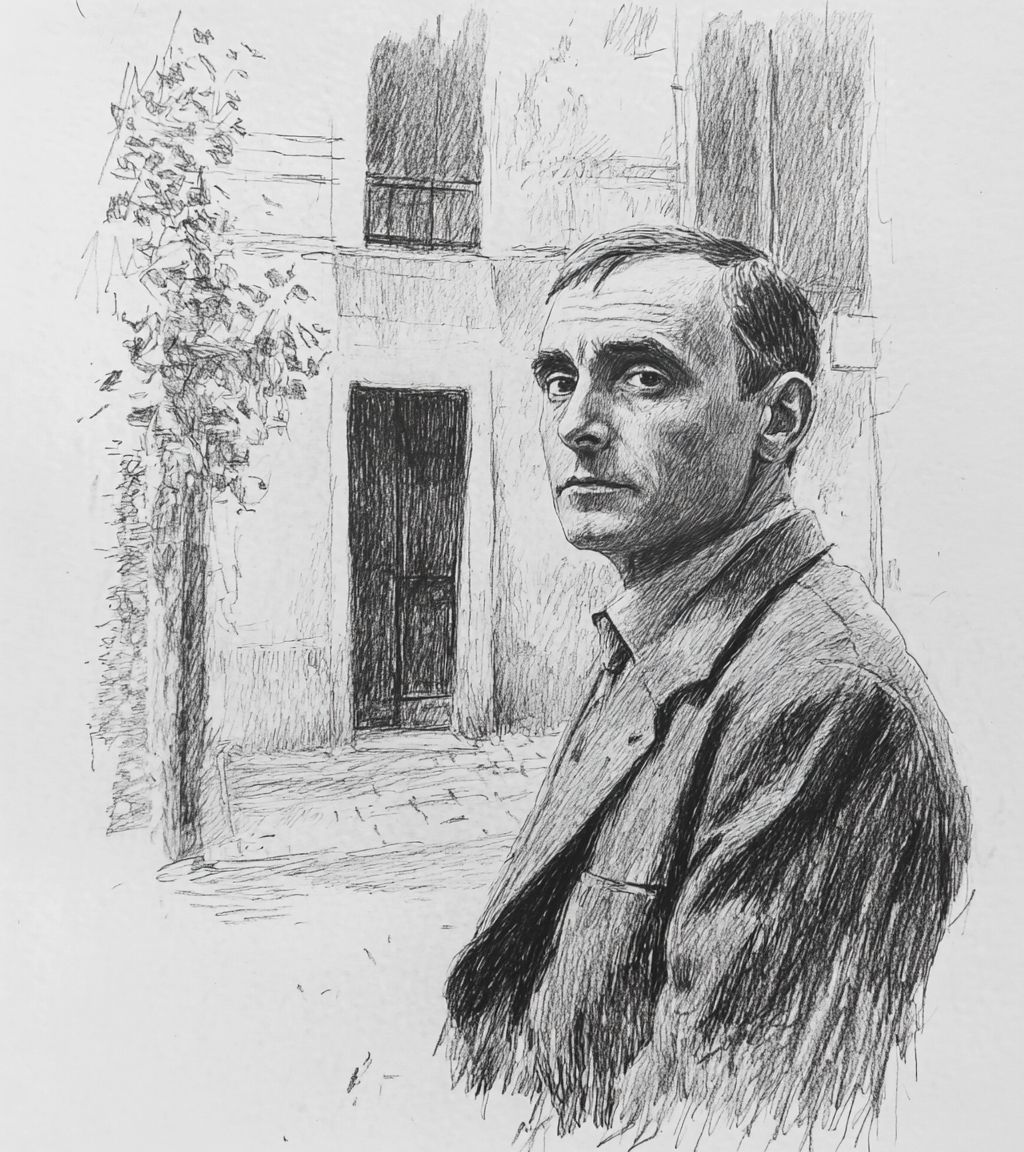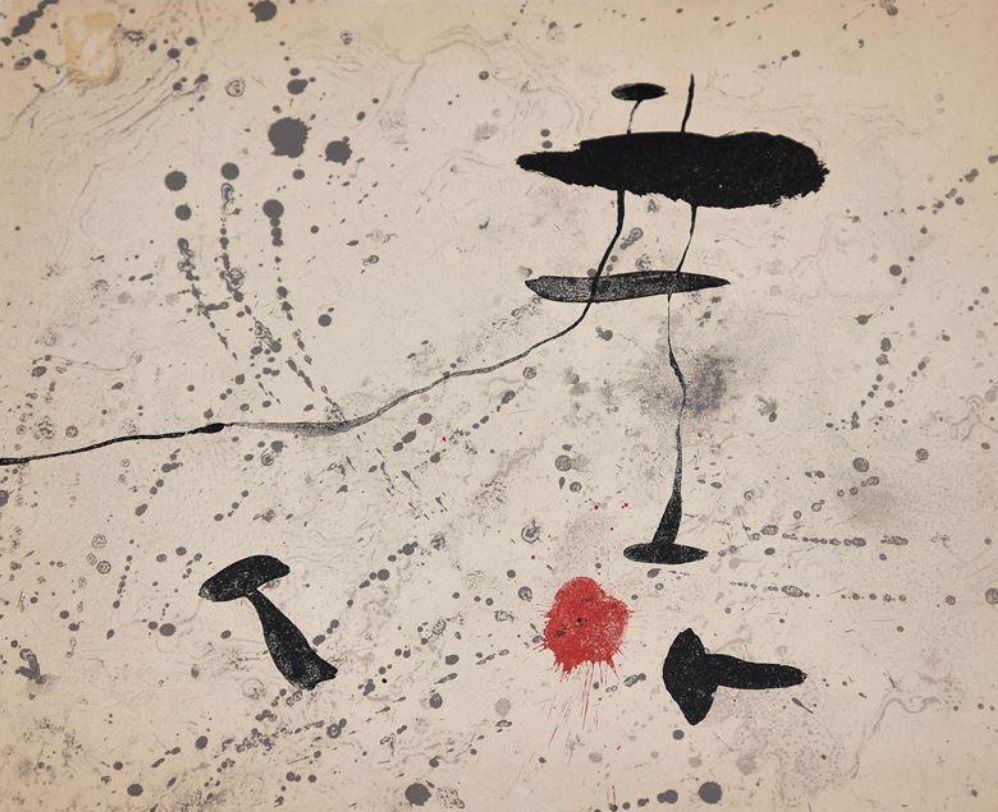
Joan Miro
Joan Miró studied at the La Lonja School of Fine Arts and later attended the Gali School of Art, where he was influenced by Catalan folk art, Romanesque church frescoes, and the color palette of post-impressionism. In 1920, he moved to Paris, where he connected with major figures of the avant-garde, including André Breton and Pablo Picasso. Although Miró maintained strong ties to his Catalan roots, his artistic development was shaped by his time in France. He lived between Paris and Spain for much of his life, and in later years established the Fundació Joan Miró in Barcelona, which opened in 1975.
Miró’s work is known for its playful, dreamlike quality, often blending abstraction with surrealist imagery. He used a visual language of floating shapes, stars, eyes, birds, and other organic forms rendered in bold colors and delicate lines. While he was associated with surrealism, he maintained a unique style that emphasized spontaneity, symbolic forms, and a rejection of traditional painting techniques. Over time, Miró expanded into other media, including sculpture, ceramics, and printmaking, experimenting with unconventional materials and surfaces while preserving his lyrical, childlike sensibility.
Some of Miró’s most iconic works include The Farm (1921–22), Harlequin’s Carnival (1924–25), Blue I, II, III (1961), and Woman and Bird (1982), the latter a monumental public sculpture in Barcelona. His work has been exhibited extensively around the world, including major retrospectives at the Museum of Modern Art (New York), Tate Modern (London), and the Centre Pompidou (Paris). The Fundació Joan Miró remains a major center for the study and exhibition of his work, showcasing hundreds of paintings, drawings, sculptures, and prints that span his long and prolific career.
Collected by major institutions and notable private collectors:
— San Francisco Museum of Modern Art (SFMOMA)— National Gallery of Art, Washington, D.C.
— Fundació Joan Miró
— Museo Reina Sofía
— Tate
Notable sales and auction records:
— Peinture (Étoile Bleue), £23,5 million at Sotheby's, London, 2012— Femme et Oiseaux, £24,5 million at Sotheby's, London, 2017
— Peinture (Femme au chapeau rouge), £22,3 million at Sotheby's, London, 2020
Artworks and Paintings
Biography and Artistic Career Highlights
Joan Miró was born on April 20, 1893, in Barcelona, Spain, into the family of a goldsmith and jeweler. His childhood took place in a Catalan environment, where craftsmanship traditions and a love of nature played an important role. From an early age, he showed interest in drawing, and his parents supported his artistic inclinations despite initially wanting him to become an accountant.
1907 — entered a business school while simultaneously attending art courses in Barcelona.
1910 — after briefly working as a clerk, he definitively decided to devote himself to painting. He began studying at the Llotja School of Art and with Francesc Galí.
1918 — held his first solo exhibition in Barcelona, which received mixed critical responses.
1920 — moved to Paris, where he met Pablo Picasso and entered the circle of avant-garde artists.
1924 — became close to the Surrealist group led by André Breton. His paintings began to feature symbolic imagery, fantastic forms, and elements of automatism.
1920s — developed a unique style that blended Catalan folklore, poetic imagery, and abstraction.
1930s — created a series of «painting-collages» and graphic works.
1941 — major retrospective at the Museum of Modern Art in New York, which brought him international recognition.
1940s–1950s — expanded into graphic arts, lithography, ceramics, and sculpture. His works became increasingly abstract, employing bright colors and simplified forms.
1954 — awarded the Grand Prize for printmaking at the Venice Biennale.
1958 — created monumental mosaics and murals for the UNESCO headquarters in Paris.
1960s — worked extensively on large-scale projects in Spain, France, and the United States, including sculptures and mosaics for public spaces.
1970s — established the Joan Miró Foundation in Barcelona (1975), which became a center for the study and promotion of his art. During this period, he focused actively on sculpture and graphic works, producing vibrant monumental pieces.
On December 25, 1983, Joan Miró died in Palma de Mallorca. His legacy holds a central place in the history of 20th-century art: he succeeded in blending poetry and abstraction, childlike play and deep philosophy, profoundly influencing the development of painting, graphic art, and sculpture.

